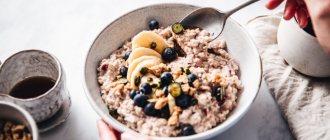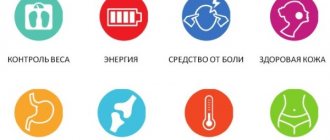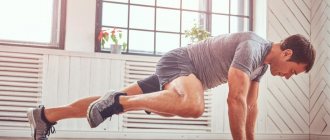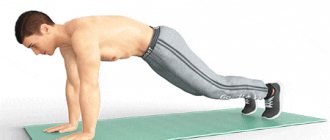How to train at home to grow muscles? What is important to know for gaining weight? The fitness trainer answers.
Have you ever encountered a situation where, due to work, you have little time for the gym, and there is no money left for personal training with a trainer? And I really want to look like an ancient Greek god or goddess. Sculpted arms, straight posture, lean torso and beautiful abs.
Let's organize our workouts to get the most out of them in the form of a couple of kilograms of pure muscle, not fat.
Egor Fukalov
fitness trainer
You will need the correct technique, a given schedule of rest and exercise, and proper nutrition.
Three pillars of muscle mass
Nutrition.
Consume the norm of proteins, fats and carbohydrates. Create a calorie surplus of 10-15% of your norm. This is how we will not gain excess fat. Body weight will not increase if you eat poorly. Include in your diet: eggs, fish, meat, green vegetables and fruits, sunflower oil, buckwheat, rice, pasta, cottage cheese, nuts, bread, honey. You don’t need to overeat, you won’t gain any more muscle, but you won’t be able to put on your favorite jeans.
For example, the following scheme is suitable for athletes: per 1 kg of weight: protein - 1.5 g, fats - 1 g, carbohydrates - 5 g. If a man weighs 70 kg, then it is necessary that the daily diet be: protein - 105 g, fats – 70 g, carbohydrates – 350 g.
Photo: istockphoto.com
Power training.
Conduct 2-4 classes per week for an hour. This is the basis for muscle development. A training diary will help you have a clear idea of which days to train, which muscles to load, how many exercises to do, approaches and repetitions. This makes it easier to track progress.
Prefer multi-joint exercises such as push-ups, squats, lunges, pull-ups, upside-down push-ups, crunches, etc. Practice technically correctly until you feel fatigue in your muscles. In order to achieve maximum effect, there must be a dynamic from easy to complex. Increase the number of repetitions and use any additional weight. For example, do push-ups with a 5-liter bottle on your back.
Photo: istockphoto.com
Recovery.
During training, we destroy protein tissue so that a new one with a small reserve takes its place. This is how, step by step, your biceps become bigger and stronger.
Muscles do not grow during training, but during rest, so sleep until you get enough sleep and try to get up without an alarm clock. The body needs to restore spent resources.
What are the features of basic exercises?
In sports, there are two main types of exercises to increase muscle mass - isolating and basic. In the first case, only one muscle is involved, for example, the biceps or gluteus. Such exercises are used to give greater definition to the body, but they cannot be used to create a harmoniously developed muscle corset or increase endurance and strength. However, basic exercises will cope with the task, since they involve a group of muscles at once. These classes have several features:
- The ability to use heavy weight, which has a beneficial effect on weight gain;
- Multi-joint exercises cause a good hormonal response in the body; hormones such as testosterone, which is involved in the growth of muscle fibers, and the growth hormone somatropin begin to be produced. The level of adrenaline, which is responsible for endurance, also increases.
A good strength load creates a stressful situation for the body, it begins to intensively rebuild and prepare to perform such tasks in the future. This is why it is important to constantly increase the weight of your equipment to gain weight.
What is important to know before training?
- Choose comfortable clothes and shoes. Uncomfortable clothing restricts movement during exercise, and you will spend more time achieving results.
- Be sure to warm up for 10-15 minutes. Exercising at home is inferior to training in the gym, where there is equipment, so use all stages of the workout more carefully: warm-up, main part, cool-down. This way you will protect yourself from possible injuries and increase the effectiveness of your training.
- Study the technique of performing each movement in detail. Understand what you are downloading.
- Watch your back and knee joints. These areas are some of the weakest and most susceptible to injury.
Newbie mistakes
To begin with, those who want to know how to pump up at home google biceps exercises and begin to do them fanatically. But the point is not at all in the biceps, but in the absence in the body of the prerequisites for creating an anabolic background. Simply put, a person simply “has nothing to grow” muscles from, especially if he neglected nutrition and believed that if he was training at home, then mashed potatoes with sausage would pass for an athlete’s diet.
The most important mistake is the reluctance to develop strength. Yes, yes, all the athletes of the “golden era” were good strength athletes. And even any modern crossfitter will perform CCM on individual movements in powerlifting. But the gloss of sports convinces us that “it will do” - bend your arms with something, do some exercises in a high-repetition mode, and you will get pumped up. No. Strength, by the way, can be developed to a certain limit at home. The only question is desire.
High expectations
Yes, guys are even worse than girls in this regard. If the latter believe that after a couple of series of glute bridges without weight and some steps to the side with elastic bands, they will look like protruding fitness bikinis, then the former are ready to argue with foam at the mouth that the same Denis Gusev could to pump up on horizontal bars if he didn’t have access to the gym. Everyone needs a role model, but if you do home fitness, you don't need to set goals like “look like a model in 3 months.”
The myth of champion volumes
Almost any person who has a photo on Instagram with huge shoulders and biceps can fit into a standard suit in life. Yes, big guys pump up their muscles before recording the results of their labors. And poor beginners do 200 repetitions with biceps expanders just to get any closer. Of course, you can develop endurance in this way, but not strength or volume.
Lack of motivation
We are not talking about videos from the Internet, where guys from the ghetto do pull-ups on the horizontal bars, and their wealthier “sports colleagues” pump iron in expensive gyms. We are talking about banal laziness. Biceps and deltoids may not be a priority for a student - for example, he is ready to play a game until 2 a.m. and then sleep through the workout. Or go have a beer instead of working out on the horizontal bars. Or... And if summer comes, you should completely forget about your studies. It's hot! In winter it is cold. In autumn - depression. And so on, in a circle. The one who will fanatically carry out the exercise program for years will get pumped up.
How to Build ALL Muscles at Home WITHOUT Iron!
Bulgarian lunges
Technique:
- The back is straight with a slight arch in the lower back, inclined towards the floor. Shoulders together, chest forward.
- Left and right legs at a 90° angle at the knees.
- The distance between the knee of the left leg and the floor is 5-10 cm.
- The left leg is used only to maintain balance.
- Take a deep breath and slowly lower yourself down until your right thigh is parallel to the floor.
- Exhale and push yourself upward with a powerful movement.
Perform three sets of 20 reps. Rest between sets is a minute.
Quick fat-burning workout in 17 minutes
Relieving lower back pain with core workouts
How many approaches and repetitions should I do?
There are “generally accepted standards” according to which to gain muscle mass you need to work within 4-5 sets of 8-12 repetitions. For exercises with a short amplitude, the number of repetitions should be increased to 20-25, and in heavy presses and rows for large muscle groups, it may be worth dropping to 6-8 repetitions. The rest time between approaches is also important; in exercises with heavy weights it is worth increasing it. It is worth understanding that all these values are generalized, you can adjust them specifically for yourself.
Push ups
Technique:
- Keep your body straight. The neck, back and hips are located in one line. Feet together.
- Distribute the load over the entire surface of your palms and fingers.
- Elbows slightly pressed to the body.
- Slowly lower yourself to a 90° angle at your elbows.
- Exhale powerfully as you rise to the top point.
- Don't straighten your elbows all the way.
Perform three sets of 10 reps. Rest between sets is a minute. You can take additional weight in the form of a backpack with books.
Photo: istockphoto.com
Squats
Technique:
- Feet shoulder width apart. The feet are slightly turned outward. Direct your gaze forward.
- Move your shoulders back a little, chest forward, and bring your shoulder blades together.
- Keep your body straight while performing the exercise with a slight arch in the lower back.
- Press your heels firmly to the floor.
- Lower yourself slowly to a 90° angle at your knees.
- From the bottom of the squat, push yourself up.
Perform three sets of 20 reps. Rest between sets is a minute. You can take additional weight in the form of a backpack with books or a five-liter bottle of water.
Crunches
Technique:
- Lie on your back. Legs bent at the knees and arms in front of you. There is no need to put them behind your head, as this will put strain on your neck.
- As you exhale, lift your upper body without lifting your lower back, holding the upper position for one second.
- As you inhale, slowly lower yourself down for two seconds.
Perform three sets of 5-10 repetitions. Rest between sets is a minute. You can take additional weight in the form of a bottle of water.
Photo: istockphoto.com
boat
Technique:
- Lie on your stomach. Stretch your arms forward and straighten your legs so that your toes are parallel to the floor.
- Raise your torso and legs up at the same time, holding the top position for one second.
- Don't forget to squeeze your shoulder blades together.
- Smoothly lower yourself down as you exhale.
Perform three sets of 15 repetitions. Rest between sets is a minute.
These exercises are more suitable for beginners rather than experienced athletes. It will not be possible to compete in a bodybuilding championship, but it is very possible to create a beautiful and healthy body with a conscientious approach.
5 bodyweight exercises that will replace the gym
How to develop your legs
It is often mistakenly believed that jumping and jumping “swing” the legs. Repeated jumping rope, running and other cardio activities are more likely to develop endurance. To develop strength, you will either have to jump on a support, for example, a box 50 cm high, or perform movements with weights.
You can realistically do the following movements at home:
- Goblet squats and pause squats;
- Lunges with dumbbells;
- Squats with dumbbells on the chest and a rubber shock absorber;
- Dumbbell floor rows and Romanian rows
- If more significant weight is required, it is recommended to either add rubber shock absorbers, or switch to “one-legged” versions of squats and deadlifts, or, nevertheless, go to the gym.
Ideal products
All these natural products will help you gain weight:
- Pasta, potatoes and sweet potatoes for carbohydrates;
- Legumes of all types - for carbohydrates and protein;
- Rice is the most accessible source of energy for a bodybuilder;
- Eggs, poultry – protein;
- Fish and seafood – protein and omega-three;
- Beef and offal – protein and iron;
- Vegetables - fiber;
- Fruits – energy of vitamins and natural simple carbohydrates;
- Nuts – for healthy fats
Increase your portions
During the rapid muscle building phase, nutrition plays a key role. If this is exactly the task you are facing now, then you need to increase the amount of food. Multiply your usual portion by approximately two times.
The size of portions can be adjusted depending on the increase in muscle mass - normally it should be 3 kg per month. If the result is higher, it means that the fat layer is also growing.
Increasing portions does not only apply to solid foods, this also applies to protein shakes. They can be prepared from the following ingredients:
- milk;
- bananas;
- cottage cheese;
- honey;
- peanut butter;
- fruits;
- yoghurts.
If there is a feeling that the body cannot cope with a large portion of food, then it is better to use a fractional intake. To do this, divide the portion into two parts and eat them after a certain period of time.
Nutrition
Mass training requires at least 4 g of carbohydrates and 2 g of protein per kilogram of weight. In this case, it is better to keep fats at the level of 1 g per kilo of current body weight. Getting calories from natural foods is a must.
Recommendations:
- Drink 2-3 liters of plain water;
- Avoid empty calories from sauces, sugar and fast food;
- Eat regularly, at regular intervals
Practice small steps - change gradually
You should not strive for quick and dramatic changes. Our body is a delicate instrument and must be handled with care. Maybe someone practices sports to the point of exhaustion and other methods of “shock therapy,” but we suggest going a different way.
Set yourself up to slowly but surely achieve your goal. Gradually switch to a new diet and eating style. If something goes wrong and you see that the fat layer is increasing instead of muscles, reconsider the quality of food you eat.
Seek advice from a trainer. He will select the training regimen that suits you and the optimal physical activity. Do not expose your body to stress and sudden changes. This can ruin all your efforts.











